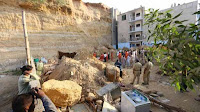At least sixty five people have died folowing a series of flash floods and landslides in Khyber Pakhtunkhwa, Azad Kashmir and Gilgit Baltistan Provinces in northern Pakistan on Sunday 3 April 2016. Forty Eight deaths have been confirmed in Azad Kashmir, including twelve in Kohistan District, largely due to landslides and house collapses. Landslides are a common problem after severe weather events, as excess
pore water pressure can overcome cohesion in soil and sediments,
allowing them to flow like liquids. Approximately 90% of all landslides
are caused by heavy rainfall. House collapses are also common following heavy rainfall in the region, largely due to the use of mud-bricks as a building material. Such
bricks are a cheap and easily obtainable building material for poorer
communities in Pakistan, but fare very badly in wet conditions. Another eight people have been reported dead following a landslide in Sharda District
Flood waters sweeping through a market in Peshawar, Khyber Pakhtunkhwa, Pakistan. Fayaz Aziz/Reuters.
In Khyber Pakhtunkhwa Province ten people are reported to have died in landslides in Shangla District, two women have been confirmed dead after they were caught in a flash flood in Swat District, and Malakand, Mansehra, Upper Dir, Charsadda, and Chitral Districts have each recorded single deaths. In Peshawar Lake Bara Khowar overflowed leading to flooding in that washed away around seventy shops and commercial properties. Nine deaths have been reported in the town of Chilas in Gilgit Baltistan Province, four of them in a single house-collapse incident.
Flooding in Gilgit Baltistan Province, Pakistan, on 4 April 2016. Dawn.
Flooding and landslices are common at this time of year in northern
Pakistan, where rising temperatues at the start of summer lead to
thawing snow and ice in the mountains of the region. However the area
does not typically recieve large amounts of rainfall at this time of
year, and the heavy rainfall which has arrived in 2016 has both caught
people by surprise and worsened the usual seasonal problems.
The Himalayan provinces of Pakistan are extremely prone to landslides, due to a
number of active faults in the area, these being driven by the northward
movement of the Indian Plate, which is pushing into Eurasia at a rate
of 40 mm a year. This causes earthquakes on both plates, as well as the
folding and uplift that has created the Himalayas and the Tibetan
Plateau.
See also...
 Flooding and landslides kill over 30 people in northern Pakistan. Thirty four people have been confirmed dead and many more are still
missing as heavy rain falls across northern Pakistan. The rainfall has
led to flooding which has affected many communities, as well as blocking...
Flooding and landslides kill over 30 people in northern Pakistan. Thirty four people have been confirmed dead and many more are still
missing as heavy rain falls across northern Pakistan. The rainfall has
led to flooding which has affected many communities, as well as blocking...At least thirteen people have died following a landslide in the Gulistan Johar District of Karachi, the capital of Sindh Province in Pakistan, early on Tuesday 13...
 Death toll thought to have exceeded 800 as heat wave hits Sindh Province, Pakistan.
The
death toll from a heat wave hitting Sindh Province in Pakistan is
thought to have exceeded 800. A total of 775 deaths had been...
Death toll thought to have exceeded 800 as heat wave hits Sindh Province, Pakistan.
The
death toll from a heat wave hitting Sindh Province in Pakistan is
thought to have exceeded 800. A total of 775 deaths had been...
Follow Sciency Thoughts on Facebook.



